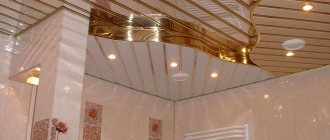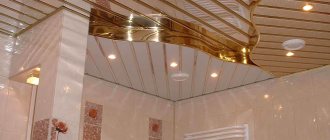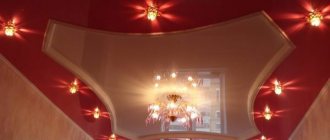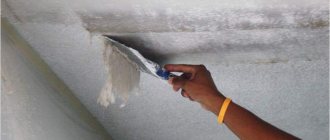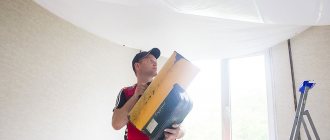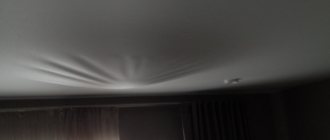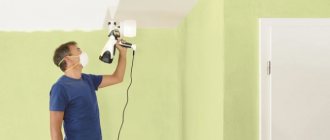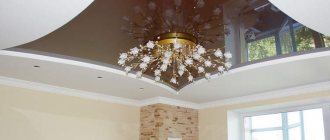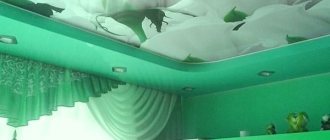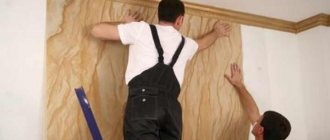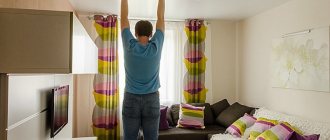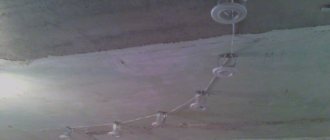The finishing of the ceiling surface can be different; one of the options is tension structures. They are quickly installed, do not require special preparation of the base and at the same time have an attractive appearance. Installation of the system is quite simple; if you wish, you can do it yourself. We’ll figure out how to install a stretch ceiling with our own hands in order to do it efficiently and without errors.
Types of suspended ceilings
To a non-specialist it may seem that all tension systems are the same. However, it is not. Despite the similar method of fastening, the stretched fabric is different. Depending on its type, the fixation method and installation technology are selected. Let's consider two main types of material.
Fabric
For tension, high-strength synthetic fabric made of polyester or polyester and impregnated with polyurethane is used. The production technology allows us to obtain only matte fabrics, but high-quality imitation of fabric of various textures is possible: chintz, suede, etc. Double-layer fabrics are also produced. In this case, an embossed decorative layer is applied to the fabric base in the form of a mesh.
Instagram potolkint_ideal
Instagram proatrium
Fabric materials are available in different finishes. They can be white or colored. In the latter case, there are few shades, no more than twenty. But they are all deep and smooth. It is possible to apply glitter and photo printing (although in the interior they may look old-fashioned). Another decorative option is translucent fabric, under which special lamps are installed. However, if they break, you will have to dismantle the old coating and install a new one.
Advantages
- The roll width is 510 cm, so seamless finishing can be done.
- Installation with minimal reduction in wall height. In a room with the correct geometry, only 15 mm is “eaten up”.
- Strength. It is possible to damage the fabric intentionally, but it is unlikely to be accidental. She is not afraid of quite serious mechanical impacts.
- Vapor permeability. Thanks to special impregnation, the fabric retains water for a short time, but at the same time allows steam and air to pass through well. This allows the structure to “breathe”.
- Wide range of “operating” temperatures. It ranges from 80 to -40°C. This makes it possible to install fabric systems in different rooms. For example, in loggias that are unheated in winter or in attics that are very hot in summer
- Fire safety. The material is treated with fire retardants, so it does not burn and does not produce smoke.
- Antibacterial effect. Bacteria and mold do not live on the surface of synthetic fibers.
- Installation is carried out without the use of heat guns.
Fabric coverings have few disadvantages, but you need to be aware of them.
Flaws
- After dismantling, the fabric cannot be re-stretched.
- Insufficient resistance to moisture. It is not recommended to install in rooms with high humidity, as “dirty” stains may appear. Despite the special impregnation, the canvas does not tolerate washing. It can only be dry cleaned. If it leaks from above, it will not hold the liquid.
- The fabric absorbs odors. It is extremely difficult to get rid of them later. Therefore, smoking, for example, in rooms with such a ceiling is not recommended.
If the width of the room where you plan to install the system is more than 5 m, you will have to make a joint and cover it with a special cover.
- Ceiling
Which stretch ceiling is better - matte or glossy: compare and choose
PVC film
Polyvinyl chloride film of various thicknesses is stretched. Unscrupulous manufacturers may use cheap toxic raw materials in the production process. When heated, such a film releases toxic substances, and after its installation there is a persistent unpleasant odor. To avoid such a result, when purchasing, you need to check the quality and safety certificate of the material.
Instagram andrei_potolki_kzn
Instagram potolki_azbuka
Film coatings are available in a variety of colors, there are dozens of them. There are matte, glossy, satin and mirror films. It is possible to use photo printing, although in modern interiors this is losing relevance.
pros
- Completely waterproof. When flooded from above, the elastic film stretches and holds the liquid inside. After draining it returns to its original shape.
- Reusable. After dismantling, the canvas can be installed again.
- Easy to care for. Dry and wet cleaning possible. Dirt can be easily washed off with soapy water. The use of aggressive chemicals is prohibited.
- Low cost of material and installation.
PVC film has many disadvantages. Let's list them all.
Minuses
- Low strength. The thin film can be easily damaged if caught with a sharp object. Champagne corks and similar impacts cause serious damage.
- The width of the canvas is small, the maximum is three meters. Thus, to finish spacious rooms it is necessary to weld two or more strips.
- Small range of “operating” temperatures. At -5°C and below, the material becomes brittle and begins to crack and collapse. Therefore, it is not used in houses with seasonal residence. High temperatures soften the plastic and it increases in size. When exposed to extreme heat, it may change color, such as yellowing, in areas near lamps.
- Quite complex installation using special equipment. The plastic strip is heated with a heat gun and tucked into the fasteners. If errors are made during the installation process, it sags or collapses, that is, sticks to the base.
- Cleaning
How and how to wash a suspended matte ceiling
Advantages
- quick installation;
- small amount of dust and dirt, waste from materials used;
- wide decorative possibilities.
Types of fastening systems
To fix the canvas, three fastening options are used.
- Harpoon. A plastic edge is welded to the edges of the cut strip. It's called a harpoon. It fits tightly into the profile. If necessary, dismantling and subsequent installation is possible. The harpoon scheme is used to fix PVC film.
- Beading. The canvas is tucked into the groove and secured with a special wedge-bead. The cutting is carried out so that there is a small allowance left. It is tucked behind the profile or cut short. The resulting seam is closed with a decorative plug.
- Clip (or cam) The fixing element in the section looks like an elongated clip. The folded edge of the fabric with an allowance is inserted into it, and it is firmly clamped with a tongue. The excess is trimmed off. The clip pattern is used only to secure the fabric.
Harpoon mount
Instagram cityceiling
Bead fastening
Instagram potolok_kiev_stellya
Clip fastening
Security measures
When installing vinyl ceilings, as we have already written, a heat gun and a gas cylinder are used, from which this gun operates. This equipment poses an increased risk. Therefore, when working, in order to avoid an explosion, all safety precautions should be observed:
- Use only gas cylinders that have not reached the end of their service life. The stamp must have the date of inspection and issue;
- The cylinder is refilled at a specialized station, where it will be checked for suitability and filled strictly according to weight. Gas filling stations are not suitable for these purposes;
- a faulty gas gun cannot be used either;
- Before work, be sure to check the integrity of the hose, the connection of the hose with the cylinder and the gun on the valve, so that there is no gas leakage anywhere;
- Under no circumstances should a switched-on gas gun be aimed at a gas cylinder.
We hope our tips will help make your home more comfortable and beautiful, and the following videos will be useful in your work.
Required tools and materials
Let's start with the tools for installing a stretch ceiling. To fix the profile you will need a hammer drill and a screwdriver. If these are models compatible with the vacuum cleaner, very good. Then it will be clean during work. It is best to mark the structure using a laser level. A regular bubble bottle will not work. The probability of error is too great. Painting cord is used to make marks. If you don't have it, you can replace it with a regular one. Before work, chalk or powder paint is applied to it.
In addition, you will need special clamps, or crocodiles, as the craftsmen call them. They pre-fix the strips. A heat gun is used to soften PVC film. Which gun you use to stretch suspended ceilings doesn’t really matter. Usually they choose one that runs on gas, although you can also take an electric one. It's safer this way. To tuck the material inside the baguette, spatulas are used. It is better to take a set with different blades. This way you can reach the most difficult to reach places.
Since you will have to work under the ceiling, select a convenient stepladder or any other support of suitable height. To cut the fastening system at an angle, you will need a miter box. Another essential tool is a metal detector. It will help determine where the hidden wiring is located. Otherwise, it may be damaged during installation work.
The necessary materials can be purchased as a kit. Stores sell kits for self-stretching ceilings. They include polyvinyl chloride film with a processed edge, profiles, a template platform for the lamp, a thermal ring, and pipe linings. In addition, it contains special glue and sealant. If for some reason the set cannot be purchased, everything must be purchased separately. In addition, you will need metallized tape and fasteners.
Some facts you need to know
- if the ceilings in your room are more than 3 meters high, then the installation time increases by 2-3 hours;
- installation of one lamp automatically adds 15-20 minutes to the installation time;
- Installing multi-level stretch ceilings in an average-sized room takes more than 10 hours.
Do-it-yourself installation of suspended ceilings: detailed step-by-step instructions
When everything necessary is prepared, they begin to work. Let's look step by step at how to stretch PVC stretch ceilings using a harpoon fastening.
Preparation
Installers advertise their services, emphasizing that compared to plastering work there will be almost no dirt and dust. Therefore, many are sure that preparation is not needed. In reality, everything is not quite like that. There is construction dust, it flies from the hammer drill, which prepares holes for fasteners. Therefore, it is better to endure everything that is possible. Cover the rest hermetically with plastic. One more thing. When a heat gun operates, the temperature in the room increases significantly. If there is a risk of damage to an item, it must be removed.
The rough ceiling also needs to be prepared. The remains of the old finish are removed from it, sagging fragments of plaster are removed, etc. The surface will be completely covered, but if the base begins to crumble, lumps will fall onto the coating and ruin it. The base prepared in this way is treated with a primer with an antiseptic effect. This will strengthen the design and prevent the possible development of fungus and mold.
The walls also need preparation. A baguette is most often attached to them, so finishing work, if planned, must be completed. The final finishing is carried out after the installation of the ceiling structure, but the rough finishing is before that: that is, the wiring must be laid, the walls must be leveled with plaster mixtures or gypsum plaster boards, primed and dried.
Instagram anastasia_wiktorovna
Instagram a_remontik.ru
Fixing a profile
Installation of a baguette for a stretch ceiling begins with markings. First, determine the height at which the fabric will be stretched. If recessed lamps are planned, the size is determined by their dimensions. Usually in such cases the ceiling is lowered by 70 mm or even lower. It is rare, but it happens that utility lines are laid along the foundation. Then the film is lowered taking into account their dimensions. In all other cases, the distance from the base is 30-50 mm.
It should be taken into account that the smaller the indentation, the more difficult it will be to work with a hammer drill. Therefore, the optimal amount of indentation is considered to be 50 mm. Particular attention is paid to the geometry of the plane. If it is not located at a right angle, the distance from the ceiling to the profile in different areas will not be the same. Marking begins from the lowest point of the overlap. The amount of indentation is set down from it.
Using a laser or regular level, transfer marks to the walls, then to the corners. The beating cord is applied in the corners, pulled tight, and the walls are marked. The basting line runs along the entire perimeter, with a planned indentation from the base. The markings mark the areas where the wiring will pass. This is necessary so as not to accidentally place fasteners in this place and puncture the wire. To do this, use a metal detector or an exact plan showing the location of the cables.
The profiles begin to be secured from any of the internal corners.
How to secure fastening systems
- Place the part against the wall so that its lower edge lies on the marking.
- Drill holes for the fasteners. Drill the baguette and the base at the same time. Be sure to skip the areas under which the wiring runs.
- Place plastic dowel inserts.
- Press the profile to the base and secure it with self-tapping screws.
After fixing, check the strength of the baguette. If it wobbles, install a few more screws. Particular attention is paid to joints. The parts must match exactly in level; large gaps between them are unacceptable. Maximum - 3 mm. Each seam must be processed so that sharp edges do not tear the PVC film. To do this, clean each edge with a file, then carefully seal the joint with tape.
External and internal corners are sheathed according to the same pattern. They take only the whole part; there should be no joints in the corners. Take measurements and mark the distance to the center of the corner on the mounting profile. Then the back side is cut with a hacksaw or grinder. For the outer corner, make three cuts, the distance between the notches is 1 cm, for the inner corner - one. Then the part is bent along the cuts, applied to the wall and secured.
Instagram potolkiug_msk
Instagram natiazhnyepotolkibaranovichi
Instagram antorsp.ru
Preparing to install lighting
On the basis, installation locations for lighting fixtures are outlined. If there are several of them, it is advisable to make a similar pattern on the floor, this will make it easier to find the embeds after stretching the fabric. A platform made of special thermoplastic is placed under each lamp. It is installed on flexible metal hangers.
How to install a platform under a lamp
- Trim the hole in the thermal platform to the required size.
- The suspension is cut into two parts or bent in the shape of a P. It is fixed to the platform on both sides with two screws.
- Apply the resulting part to the ceiling, mark points for fasteners.
- Drill holes and install plastic dowels.
- They put the mortgage in place and secure it with self-tapping screws.
Important point. The bottom edge of the platform should ultimately be flush with the stretched fabric. To control this, you need to pull the thread between the fixed profiles. The protruding thermal platform is raised slightly. To do this, bend the suspension. If there is such a need, they lay the wiring, that is, assemble a lighting system. The cable is laid in a corrugated pipe and secured to hangers.
Instagram potolkiug_msk_
Instagram potolkiug_msk
Fabric preparation
No complex preparatory work is required before installation. However, the masters recommend certain procedures to be carried out. The film must be carefully unpacked and straightened. It is necessary to allow her to “acclimatize” indoors. This is especially important if the material was in a cool place. There may be creases on the surface; they form during long-term storage in a tightly folded form. Over time they will straighten out. An important point: you cannot place anything on the unfolded covering, otherwise you can damage it.
Fastening the canvas
Before starting work, close the doors and windows in the room tightly. Crocodile devices are attached to the corners. The PVC film is laid out so that the harpoon mount is directed downward with its curved part. Alternately fix its corners with a crocodile clothespin, hanging it above the floor. After this, they begin to heat up the film. To do this, turn on a heat gun. It is directed at the plastic from a distance of at least 1 m. The direction of heating must be constantly changed, otherwise the plastic may be damaged.
After the room temperature rises to 50°C, the polyvinyl chloride begins to soften. It becomes plastic and stretches easily. The harpoon edge also softens. Now you can easily insert it into your profile. The PVC film is pulled up and tucked into the profile. To do this, use a special spatula to pry up the edge and insert it into the recess on the baguette. The spatula is carefully removed.
Start from any corner, then fix the film in the opposite one. After this, do the same with the two remaining corners. After the film is tucked into all corners, move to the center of one of the walls. Fix the material, moving from the center to the corners along the entire perimeter. There is no need to adjust the tension level. When cutting, the dimensions are precisely observed and after cooling the ceiling will take the desired shape. But distortions are unacceptable. They lead to the formation of permanent folds.
We have described harpoon fastening technology, which is used only for polyvinyl chloride. For fabric ceilings, a slightly different technique is used.
Instagram brain_and_home
ShutterStock
ShutterStock
Nuances when working with fabric
Let's look at how to stretch a suspended ceiling without a gas gun. The stages of preparation, securing baguettes and installing mortgages are carried out similarly. They begin to fix the fabric from the middle of one of the walls, then fasten the opposite section and tuck the fabric on the two remaining walls. Using a spatula, tuck the canvas inside the baguette, then carefully remove the tool.
Move from the center to the corners, gradually stretching the entire coating. Distortions must be avoided. The workpiece is cut out with an allowance, so it needs to be stretched well before being tucked inside the profile. It is advisable to work with an assistant. A coating that is not stretched well enough will quickly sag. It is fixed in a clip or glazing bead baguette. After all the material has been tucked in, the excess is cut off with a sharp knife and tucked under the baguette.
Chandelier installation
They start by turning off the power to the room. To put the lamp in place, you need to find the place under the stretched covering where the embed is located. A thermal ring is glued to the previously installed platform from the outside. This must be done carefully so that both parts match completely. After the glue has dried, use a sharp knife to cut a hole inside the thermal ring. The wires are removed from the resulting cavity and connected to the built-in lamp. Then bend the installation springs and put the device in place. The chandelier is mounted in the same way. The difference is that it is not recessed into the surface, but is attached to the mortgage with self-tapping screws.
ShutterStock
ShutterStock
ShutterStock
- Ceiling
Installing a chandelier on a suspended ceiling with your own hands: simple instructions
How much time will it take?
The exact answer to the question depends on the specifics of the room in which the installation is planned, as well as on a number of other factors. However, the approximate installation duration, which will serve as a guide for you, can still be derived without any problems. We have reflected it in the form of a compact and quite clear table:
| Room | Approximate installation time |
| kitchen | 3 hours |
| bathroom | 2-3 hours |
| corridor | 2-3 hours |
| hall | 3-4 hours |
| two-level ceiling | 9-10 hours or more |
The duration is also influenced by the following factors:
- the number of lighting fixtures planned for installation on the canvas;
- ceiling height;
- strength of wall structures;
- additional installation of ceiling cornice;
- the presence of pipes and alcoves;
- nature of the design;
- presence of hood.
